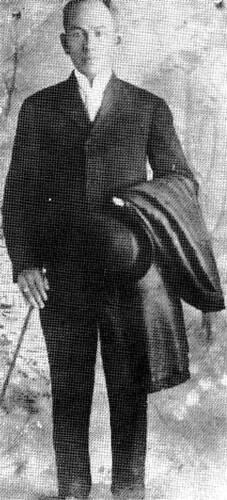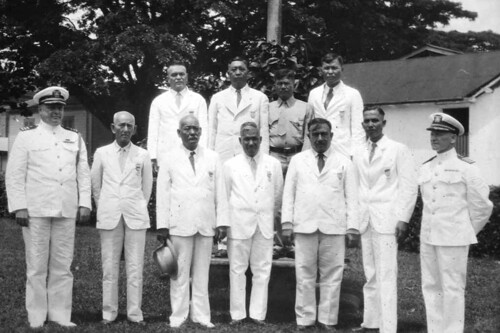First postmaster of Guam, first Secretary to the Governor during US Naval Era
Atanasio Taitano Perez (1874 – 1950), commonly known as Don Perez, is the only child of Francisco Taitano Perez and Maria Encarnacion Perez. He was born in Hong Kong on 5 June 1874. While being raised and living in Hong Kong he received his early education and subsequently attended St. Joseph’s College. By the late 1800’s, his father decided that it was time for his family to return home to Guam.
On 11 January 1894 he married Carmen Arriola Duenas, daughter of Agustin Evaristo Duenas and Domitila Rivera Arriola. Together, they had 13 children; however, only six of their daughters survived beyond childhood. Their children who lived to be adults were Maria, Isabel, Eliza Rita, Beatrice, Ursula and Brigida Taitano Perez.
Perez was a highly successful public servant for Guam since 1 August 1899, retiring on 1 June 1935. He held key government positions over many US Naval government administrations including:
- An appointment as a Clerk and Interpreter by Acting Governor William Coe on 1 August 1899
- Appointment as the first Postmaster of Guam on 29 July 1901 when the first post office of Guam was is directed to be established
- An appointment as a Special Laborer to oversee the Commissary Store, Clothing and Small Stores
- A promotion to Chief Clerk on 5 March 1906
- An appointment as Associate Justice in the Guam Court of Appeals, 15 July 1916
- An appointment as member of the Guam Higher Court of Equity, 20 September 1916
- An appointment as Associate Justice in Guam Higher Court of Equity 10 September 1917.
In recognition for his work and performance, he received a title change from Chief Clerk to Secretary to the Governor in 1931.
Perez spoke CHamoru, English, Spanish, Portuguese and Cantonese-Chinese.
In addition to government service, Perez was also personally involved in the movement petitioning Congress to establish a permanent civilian government and United States Citizenship for the people of Guam. He was one of the 32 signatory officials of Guam that petitioned Congress in 1901.
In 1925 when some members of the US House of Representatives visited Guam, they attended a Guam Congress session held in Dorn Hall on 1 July. Following Naval Governor Henry Price’s welcoming remarks and comments, Perez was the first to present and address on behalf of the CHamoru people:
Gentlemen of Congress, the CHamorus today occupy an anomalous position. One of the masterpieces of American literature tells of a man, who, because of the proud contemptuousness with which he regarded his country, was made an outcast from the land and became “A Man Without a Country.” We also are without a country. Since 1899 the question of the status of the CHamorus has been intermittently discussed in Washington, but no effective steps have been taken to grant us citizenship in the country we look on as our own.
The CHamorus are neither citizens nor aliens – they are truly without a country. When the United States acquired sovereignty over the Virgin Islands, citizenship was immediately conferred on the inhabitants, but Guam, for 26 years an American possession, has not yet been granted that privilege.
We appeal to the American ideals and sense of justice. May I, on behalf of my fellow CHamorus, beg that you give this subject your consideration, and may I hope that Congress will see fit to retain our appreciation and strengthen our loyalty by granting us the title we would prize above all others – Citizens of the United States.
Perez’ point about CHamorus being without a country is supported by a 1901 court case opined by United States Federal District Court Judge Morris M. Estee. The case involved a CHamoru named Comanche [possibly Camacho] who was a resident in Hawai’i for many years. On 26 June 1901 Estee intimated that the court could not grant citizenship to him, but “only to Polynesians admitted to citizenship being the Hawaiians, admitted by act of Congress.”
While Congress remained unresponsive to Guam’s pleas for citizenship and civilian governance, during World War II, and just two weeks before the US stormed ashore to repossess Guam, Perez lost his left eye from flying shell fragments while he was in a bomb shelter on 7 July 1944 in Hagåtña. In addition to that injury, he sustained other wounds and powder burns about his legs and face. As if that was not enough, the upper lobe of one of his ears was pierced by a bullet.
It is unfortunate that Perez did not live to see the day of his passionate efforts of when the CHamoru people of Guam would finally become US Citizens and a government that would later transition from the Navy to a civilian government. He died 23 April 1950, just a few months before President Harry Truman signed the Guam Organic Act into law on 1 August 1950.
The Agana Post Office was renamed in his honor in December 2022.
For further reading
Appointment of Postmasters, 1832 – September 30, 1971. Records of the Post Office Department [POD], Record Group (RG) 28. No. M841, Roll 18. National Archives and Records Administration (NARA), Washington, DC.
“Chamorros Make Plea for US Citizenship.” The Guam Recorder 2, no. 17 (1925): 131-133.
I Manfåyi: Who’s Who in Chamorro History. Vol. 1. The Hale’-ta Series. Hagåtña: Political Status Education and Coordinating Commission, 1995.
Souder, Paul B. 1978. “Heritage: A Genealogy of the Souder-Torres and Affiliated Families Throughout the Nineteenth and Twentieth Centuries.” Unpublished manuscript, 1978. Micronesian Area Research Center, University of Guam.
“Who’s Who in Guam: Mr. Atanasio Taitano Perez.” The Guam Recorder 13, no. 11 (February 1937): 4.





